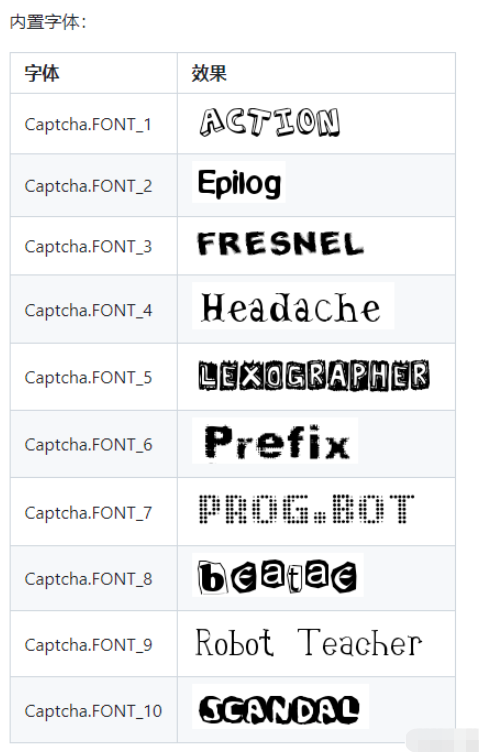
There are many ways to generate verification codes. The easy-captcha toolkit is chosen here.
The original address of github is: easy-captcha tool kit
This module provides Java graphical verification code support, including gif, Chinese, arithmetic and other types, and is suitable for projects such as Java Web and JavaSE.
First, you need to add the dependency configuration file of easy-captcha to the pom.xml file.
The import dependency statement has been written in the open source project, just copy and paste it.

<dependency>
<groupId>com.github.whvcse</groupId>
<artifactId>easy-captcha</artifactId>
<version>1.6.2</version>
</dependency>
//生成验证码对象 SpecCaptcha captcha = new SpecCaptcha(130, 48, 5); //设置验证码的字符类型 captcha.setCharType(Captcha.TYPE_ONLY_NUMBER);

//生成验证码对象
SpecCaptcha captcha = new SpecCaptcha(130, 48, 5);
// 设置内置字体
captcha.setFont(Captcha.FONT_1);
// 设置系统字体
captcha.setFont(new Font("楷体", Font.PLAIN, 28));The output method of base64 encoding is as follows:
SpecCaptcha specCaptcha = new SpecCaptcha(130, 48, 5);
specCaptcha.toBase64();
// 如果不想要base64的头部data:image/png;base64,
specCaptcha.toBase64(""); // 加一个空的参数即可FileOutputStream outputStream = new FileOutputStream(new File("C:/captcha.png"))
SpecCaptcha specCaptcha = new SpecCaptcha(130, 48, 5);
specCaptcha.out(outputStream);@Controller
public class KaptchaController {
@GetMapping("/kaptcha")
public void defaultKaptcha(HttpServletRequest httpServletRequest, HttpServletResponse httpServletResponse) throws Exception{
httpServletResponse.setHeader("Cache-Control","no-store");
httpServletResponse.setHeader("Pragma","no-cache");
httpServletResponse.setDateHeader("Expires",0);
httpServletResponse.setContentType("image/gif");
//生成验证码对象,三个参数分别是宽、高、位数
SpecCaptcha captcha = new SpecCaptcha(130, 48, 5);
//设置验证码的字符类型为数字和字母混合
captcha.setCharType(Captcha.TYPE_DEFAULT);
// 设置内置字体
captcha.setCharType(Captcha.FONT_1);
//验证码存入session
httpServletRequest.getSession().setAttribute("verifyCode",captcha.text().toLowerCase());
//输出图片流
captcha.out(httpServletResponse.getOutputStream());
}
}<!DOCTYPE html>
<html lang="en">
<head>
<meta charset="UTF-8">
<title>验证码显示</title>
</head>
<body>
<img src="/kaptcha" onclick="this.src='/kaptcha?d='+new Date()*1" / alt="How to implement springboot verification code generation and verification functions" >
</body>
</html>http://localhost:8080/kaptcha

public String verify(@RequestParam("code") String code, HttpSession session){
if (!StringUtils.hasLength(code)){
return "验证码不能为空";
}
String kaptchaCode = session.getAttribute("verifyCode")+"";
if (!StringUtils.hasLength(kaptchaCode)||!code.toLowerCase().equals(kaptchaCode)){
return "验证码错误";
}
return "验证成功";
}<!DOCTYPE html>
<html lang="en">
<head>
<meta charset="UTF-8">
<title>验证码测试</title>
</head>
<body>
<img src="/kaptcha" onclick="this.src='/kaptcha?d='+new Date()*1" / alt="How to implement springboot verification code generation and verification functions" >
<br>
<input type="text" maxlength="5" id="code" placeholder="请输入验证码" />
<button id="verify">验证</button>
<br>
<p id="verifyResult">
</p>
</body>
<!--jqGrid依赖jQuery,因此需要先引入jquery.min.js文件,下方地址为字节跳动提供的cdn地址-->
<script src="http://s3.pstatp.com/cdn/expire-1-M/jquery/3.3.1/jquery.min.js"></script>
<script type="text/javascript">
$(function () {
//验证按钮的点击事件
$('#verify').click(function () {
var code = $('#code').val();
$.ajax({
type: 'GET',//方法类型
url: '/verify?code='+code,
success: function (result) {
//将验证结果显示在p标签中
$('#verifyResult').html(result);
},
error:function () {
alert('请求失败');
},
});
});
});
</script>
</html>在用户识别并呈现在页面上的验证码之后,他们可以在输入框中输入验证码并点击“验证”按钮。在JS代码中已经定义了“验证”按钮的点击事件,一旦点击,就会获取用户在输入框中输入的内容,并将其作为请求参数向后端发送请求,验证用户输入的验证码是否正确,后端在处理完成后会返回处理结果,拿到处理结果就显示在id为verifyResult的p标签中。

The above is the detailed content of How to implement springboot verification code generation and verification functions. For more information, please follow other related articles on the PHP Chinese website!




